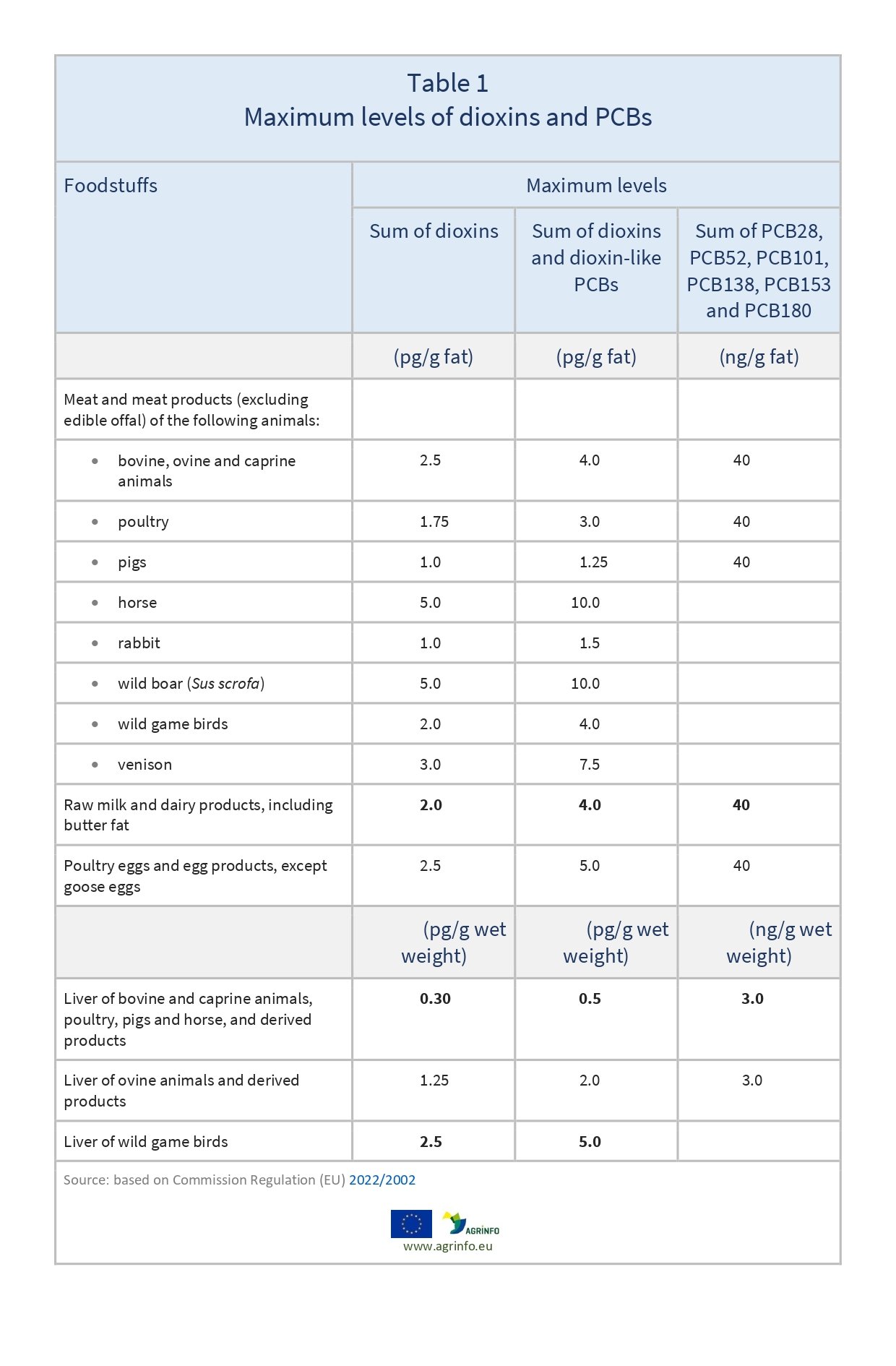Maximum levels of dioxins and PCBs
- Contaminants
Summary
The European Commission has published Regulation 2022/2002 that introduces new maximum levels of dioxins and dioxin-like polychlorinated biphenyls (PCBs) on certain foodstuffs. It extends the current maximum level for hen eggs to all poultry eggs and lowers the maximum levels in milk and dairy products.
New dioxin maximum levels on certain animal products, including eggs, crustaceans, and milk and dairy products, from 1 January
Commission Regulation (EU) 2022/2002 of 21 October 2022 amending Regulation (EC) No 1881/2006 as regards maximum levels of dioxins and dioxin-like PCBs in certain foodstuffs
Update
The European Commission has published Regulation 2022/2002 that introduces new maximum levels of dioxins and dioxin-like polychlorinated biphenyls (PCBs) on certain foodstuffs. It extends the current maximum level for hen eggs to all poultry eggs and lowers the maximum levels in milk and dairy products.
Impacted Products
poultry eggs, egg products (except goose eggs), meat and edible offal of cattle, pigs, poultry, sheep, goats, horses, rabbits, wild boar, venison, wild game birds, raw milk and dairy products
What is changing?
The EU amends Section 5 "Dioxins and PCBs" of the Annex to Regulation (EC) No 1881/2006 (subsequently replaced by Regulation (EU) 2023/915) establishing maximum levels for dioxins, and for the sum of dioxins and dioxin-like PCBs, for foodstuffs not yet covered by EU legislation, and for which occurrence data have been recently made available. New products and amendments include:
- meat and meat products from goats, horses, rabbits, wild boar, game birds and venison; and liver of goats, horses and game birds
- the existing maximum level for hen eggs is extended to all poultry eggs, with the exception of goose eggs.
The maximum levels for these products are listed in Table 1.
Why?
Estimates of chronic human dietary exposure to dioxins and dioxin-like PCBs, based on the available occurrence data, indicate a significant exceedance of the tolerable weekly intake for populations of all age groups.
Timeline
Date of entry into force: 1 January 2023.
Foodstuffs placed on the market before 1 January 2023 may remain on the market until their date of minimum durability or use-by date, even if new maximum levels are exceeded.
What are the major implications for exporting countries?
Dioxins, formed unintentionally in a number of industrial and thermal processes, have no technological use. The production of polychlorinated biphenyls (PCBs) had widespread use up to the end of the 1970s, but has since been abandoned in most countries (EFSA CONTAM Panel 2018). However, due to their poor degradation, dioxins and PCBs have accumulated in the food chain.
Third countries where industrial and thermal processes involving the use of PCBs or unintentional formation of dioxins have been absent or less concentrated, are less likely to be directly concerned by this Regulation. This could present a competitive advantage for such countries to export foodstuffs that have low levels of these contaminants.
Recommended Actions
AGRINFO stakeholders should monitor the presence of dioxins, and specifically PCBs, in the products impacted by this Regulation. Where levels of dioxins and/or PCBs in excess of the levels recommended in food are found, partners must initiate investigations to identify the source of contamination and take measures to reduce or eliminate the source of contamination.
Commission Regulation 2017/644 specifies the sampling procedure and the methods of analysis for the official control of levels of dioxins and PCBs.
Background
Council Regulation (EEC) No 315/93 of 8 February 1993 lays down Community procedures for contaminants in food.
Commission Regulation (EU) 2023/915 of 25 April 2023 on maximum levels for certain contaminants in food and repealing Regulation (EC) No 1881/2006
In 2018 EFSA adopted a Scientific Opinion on the risks for animal and public health related to the presence of dioxins and dioxin-like PCBs in feed and food (EFSA CONTAM Panel 2018). EFSA established a tolerable weekly intake of 2 pg TEQ (toxic equivalence) per kg body weight per week for the sum of dioxins and dioxin-like PCBs. Estimates of chronic human dietary exposure to dioxins and dioxin-like PCBs based on the available occurrence data indicate a significant exceedance of the tolerable weekly intake for populations of all age groups.
Resources
EFSA CONTAM Panel (2018) Risk for animal and human health related to the presence of dioxins and dioxin-like PCBs in feed and food. EFSA Journal, 16(11): e05333.
European Commission (2013) Commission Recommendation of 3 December 2013 on the reduction of the presence of dioxins, furans and PCBs in feed and food.
Sources
Tables & Figures

.
Disclaimer: Under no circumstances shall COLEAD be liable for any loss, damage, liability or expense incurred or suffered that is claimed to have resulted from the use of information available on this website or any link to external sites. The use of the website is at the user’s sole risk and responsibility. This information platform was created and maintained with the financial support of the European Union. Its contents do not, however, reflect the views of the European Union.
